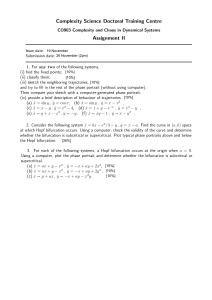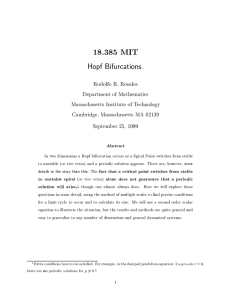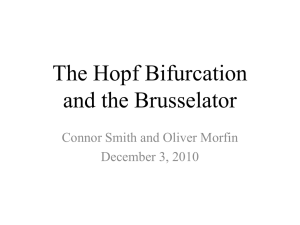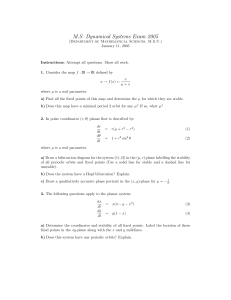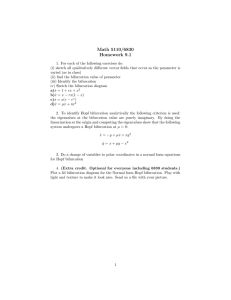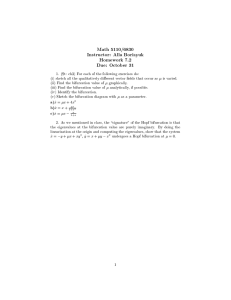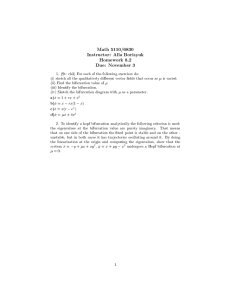Document 13574176
advertisement
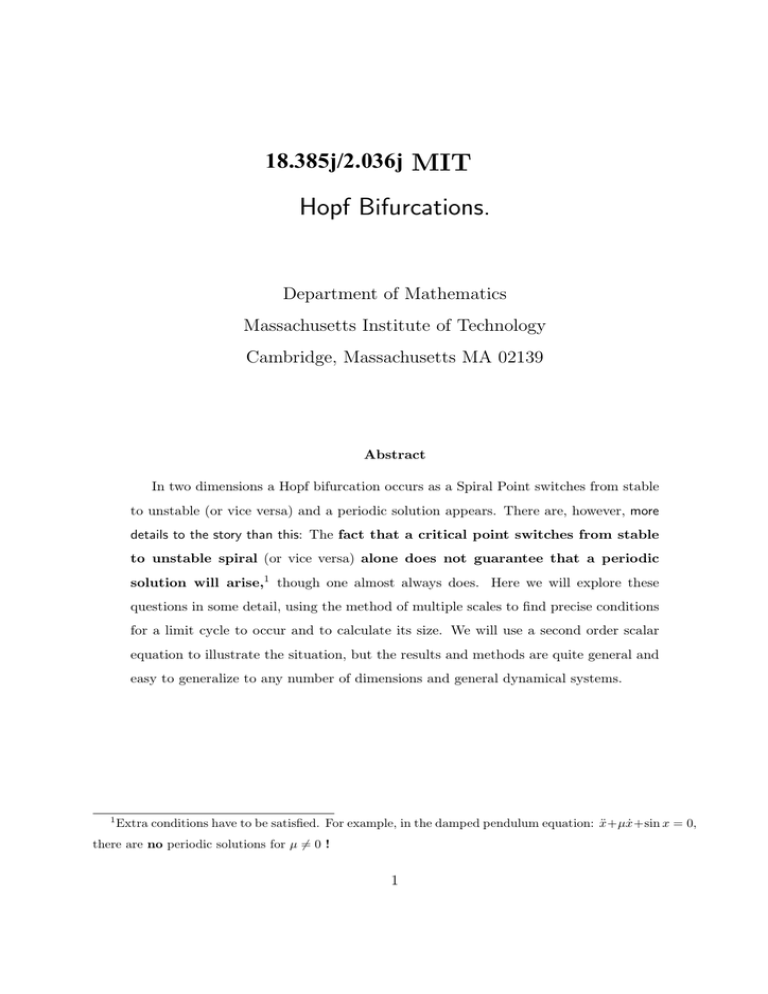
18.385j/2.036j MIT
Hopf Bifurcations.
Department of Mathematics
Massachusetts Institute of Technology
Cambridge, Massachusetts MA 02139
Abstract
In two dimensions a Hopf bifurcation occurs as a Spiral Point switches from stable
to unstable (or vice versa) and a periodic solution appears. There are, however, more
details to the story than this: The fact that a critical point switches from stable
to unstable spiral (or vice versa) alone does not guarantee that a periodic
solution will arise,1 though one almost always does. Here we will explore these
questions in some detail, using the method of multiple scales to find precise conditions
for a limit cycle to occur and to calculate its size. We will use a second order scalar
equation to illustrate the situation, but the results and methods are quite general and
easy to generalize to any number of dimensions and general dynamical systems.
1
Extra conditions have to be satisfied. For example, in the damped pendulum equation: x+µẋ+sin
¨
x = 0,
there are no periodic solutions for µ �= 0 !
1
18.385j/2.036j MIT Hopf Bifurcations.
2
Contents
1 Hopf bifurcation for second order scalar equations.
3
1.1
Reduction of general phase plane case to second order scalar. . . . . . . . . .
3
1.2
Equilibrium solution and linearization. . . . . . . . . . . . . . . . . . . . . .
3
1.3
Assumptions on the linear eigenvalues needed for a Hopf bifurcation. . . . .
4
1.4
Weakly Nonlinear things and expansion of the equation near equilibrium. . .
5
1.5
Explanation of the idea behind the calculation.
. . . . . . . . . . . . . . . .
5
1.6
Calculation of the limit cycle size. . . . . . . . . . . . . . . . . . . . . . . . .
6
1.7 The Two Timing expansion up to O(�3 ). . . . . . . . . . . . . . . . . . . . .
7
Calculation of the proper scaling for the slow time. . . . . . . . . . .
7
Resonances occur first at third order. Non­degeneracy. . . . . . . . .
8
Asymptotic equations at third order.
. . . . . . . . . . . . . . . . . .
8
Supercritical and subcritical Hopf bifurcations. . . . . . . . . . . . . .
9
1.7.1
Remark on the situation at the critical bifurcation value. . . . . . . .
9
1.7.2
Remark on higher orders and two timing validity limits. . . . . . . . .
10
1.7.3
Remark on the problem when the nonlinearity is degenerate. . . . . .
10
18.385j/2.036j MIT Hopf Bifurcations.
1
3
Hopf bifurcation for second order scalar equations.
1.1
Reduction of general phase plane case to second order scalar.
We will consider here equations of the form
ẍ + h(ẋ, x, µ) = 0 ,
(1.1)
where h is a smooth and µ is a parameter.
Note 1 There is not much loss of generality in studying an equation like (1.1), as
opposed to a phase plane general system. For let:
ẋ = f (x, y, µ) and
ẏ = g(x, y, µ) .
(1.2)
Then we have
ẍ = fx ẋ + fy ẏ = fx f + fy g = F (x, y, µ) .
(1.3)
Now, from ẋ = f (x, y, µ) we can, at least in principle,2 write
y = G(ẋ, x, µ) .
(1.4)
Substituting then (1.4) into (1.3) we get an equation of the form (1.1).3
1.2
Equilibrium solution and linearization.
Consider now an equilibrium solution4 for (1.1), that is:
x = X(µ) such that h(0, X, µ) = 0 ,
2
(1.5)
We can do this in a neighborhood of any point (x∗ , y∗ ) (say,a critical point) such that fy (x∗ , y∗ , µ) �= 0,
� 0, then the same ideas yield an equation
as follows from the Implicit Function theorem. If fy = 0, but gx =
of the form ÿ + �
h(y,
˙ y, µ) = 0 for some �
h. The approach will fail only if both fy = gx = 0. But, for a
critical point this last situation implies that the eigenvalues are fx and gy , that is: both real ! Since we are
interested in studying the behavior of phase plane systems near a non–degenerate critical point switching
from stable to unstable spiral behavior, this cannot happen.
3
Vice versa, if we have an equation of the form (1.1), then defining y by y = G(ẋ, x, µ), for any G such
that the equation can be solved to yield ẋ = f (x, y, µ) (for example: G = ẋ), then ẏ = Gẋ x
¨ + Gx ẋ = g(x, y)
¨ = −h.
upon replacing ẋ = f and x
4
i.e.: a critical point.
18.385j/2.036j MIT Hopf Bifurcations.
4
so that x ≡ X is a solution for any fixed µ. There is no loss of generality in assuming
X(µ) ≡ 0 for all values of µ ,
(1.6)
since we can always change variables as follows: xold = X(µ) + xnew .
The linearized equation near the equilibrium solution x ≡ 0 (that is, the equation for x
infinitesimal) is now:
ẍ − 2αẋ + βx = 0 ,
(1.7)
where α = α(µ) = − 21 hẋ (0, 0, µ) and β = β(µ) = hx (0, 0, µ) .
The critical point is a spiral point if β > α2 . The eigenvalues and linearized solution
are then
� =
(where ω
�
λ = α ± iω
(1.8)
� − t0 )) ,
x = aeαt cos (ω(t
(1.9)
√
β − α2 ) and
where a and t0 are constants.
1.3 Assumptions on the linear eigenvalues needed for a Hopf bi­
furcation.
Assume now: At µ = 0 the critical point changes from a stable to an unstable spiral
point (if the change occurs for some other µ = µc , one can always redefine µold = µc +µnew ).
Thus
α < 0 for µ < 0 and α > 0 for µ > 0, with β > 0 for µ small.
In fact, assume:
• I.
h is smooth.
• II.
α(0) = 0, β(0) > 0 and
d
α(0) > 0 .5
dµ
⎫
⎪
⎬
⎪
⎭
(1.10)
We point out that, in addition, there are some restrictions on the behavior of
the nonlinear terms near the critical point that are needed for a Hopf bifurcation
to occur. See equation (1.22).
5
This last is known as the Transversality condition. It guarantees that the eigenvalues cross the imaginary
axis as µ varies.
18.385j/2.036j MIT Hopf Bifurcations.
1.4
5
Weakly Nonlinear things and expansion of the equation near
equilibrium.
Our objective is to study what happens near the critical point, for µ small. Since for µ = 0 the
critical point is a linear center, the nonlinear terms will be important in this study. Since
we will be considering the region near the critical point, the nonlinearity will be weak.
Thus we will use the methods introduced in the Weakly Nonlinear Things notes.
For x, ẋ, and µ small we can expand h in (1.1). This yields
x¨ + ω02 x +
+
�
�
1
1
2
2
Aẋ
+
B
xx
˙
+
Cx
+
2
2
�
1
3
2
˙ 2
6 Dẋ + 3Eẋ x + 3F xx
+ Gx3
− 2p2 ẋµ + Ωxµ + O(�4 , �2 µ, �µ2 )
�
(1.11)
= 0,
where we have used that h(0, 0, µ) ≡ 0 and α(0) = 0. In this equation we have:
∂
h(0, 0, 0) = β(0) > 0, with ω0 > 0,
∂x
A. ω02 =
B. A =
∂2
h(0, 0, 0),
∂ẋ2
C. p2 = −
D. Ω =
B=
∂2
h(0, 0, 0) , . . .,
∂ ẋ∂x
1 ∂2
d
h(0, 0, 0) =
α(0) > 0, with p > 0,
2 ∂ ẋ∂µ
dµ
∂2
d
h(0, 0, 0) =
β(0),
∂x∂µ
dµ
E. � is a measure of the size of (x, ẋ). Further: both � and µ are small.
1.5
Explanation of the idea behind the calculation.
We now want to study the solutions of (1.11). The idea is, again: for � and µ small the
solutions are going to be dominated by the center in the linearized equation x
¨ + ω02 x = 0,
with a slow drift in the amplitude and small changes to the period6 caused by the higher
order terms. Thus we will use an approximation for the solution like the ones in section 2.1
of the Weakly Nonlinear Things notes.
6
We will not model these period changes here. See section 2.3 of the Weakly Nonlinear Things notes for
how to do so.
18.385j/2.036j MIT Hopf Bifurcations.
1.6
6
Calculation of the limit cycle size.
An important point to be answered is:
What is epsilon?
(1.12)
This is a parameter that does not appear in (1.1) or, equivalently, (1.11). In fact, the only
parameter in the equation is µ (assumed small as we are close to the bifurcation point µ = 0).
Thus:
� must be related to µ.
(1.13)
In fact, � will be a measure of the size of the limit cycle, which is a property of the
equation (and thus a function of µ and not arbitrary all).
However:
We do not know � a priori! How do we go about determining it?
The idea is: If we choose � “too small” in our scaling of (x, ẋ), then we will be looking
“too close” to the critical point and thus will find only spiral­like behavior, with no limit
cycle at all. Thus, we must choose � just large enough so that the terms involving
µ in (1.11) (specifically 2p2 µẋ, which is the leading order term in producing the sta­
ble/unstable spiral behavior) are “balanced” by the nonlinearity in such a fashion that
a limit cycle is allowed. In the context of Two–Timing this means we want µ to “kick
in” the damping/amplification term 2p2 µẋ at “just the right level” in the sequence of
solvability conditions the method produces. Thus, going back to (1.11), we see that7
• The linear leading order terms x¨ + ω02 x appear at O(�).
• The first nonlinear terms (quadratic) appear at O(�2 ).
1
However: Quadratic terms produce no resonances, since sin2 θ = (1 − cos 2θ) and
2
there are no sine or cosine terms. The same applies to cos2 θ and to
sin θ cos θ.
• Thus, the first resonances will occur when the cubic terms in x play a role ⇒ we must
have the balance
O(x3 ) = O(µẋ) ,
(1.14)
⇒ µ = O(�2 ).
7
This is a crucial argument that must be well understood. Else things look like a bunch of miracles!
18.385j/2.036j MIT (Rosales) Hopf Bifurcations.
1.7
7
The Two Timing expansion up to O(�3 ).
We are now ready to start. The expansion to use in (1.11) is
x = �x1 (τ, T ) + �2 x2 (τ, T ) + �3 x3 (τ, T ) + . . . ,
(1.15)
where 0 < � � 1, 2π–periodicity in T is required, T = ω0 t, ω0 is as in (1.11)8 , τ is a slow
time variable and � is related to µ by µ = ν�2 , where ν = ±1 (which ν we take depends
on which “side” of µ = 0 we want to investigate).
What exactly is τ ? Well, we need τ to resolve resonances, which will not occur until the cubic
terms kick in into the expansion ⇒ τ = �2 t. (This is exactly the same argument used to
get (1.14)).
Then, with
�
∂
∂T
=
, (1.11) becomes:
ω02 x�� + ω02 x +
1
6
�
1
Aω02 (x� )2
2
+ Bω0 xx� + 12 Cx2
�
+
(1.16)
{Dω03 (x� )3 + 3Eω02 (x� )2 x + 3F ω0 x� x2 + Gx3 } +
2�2 ω0 x�τ − 2�2 νp2 ω0 x� + �2 νΩx + O(�4 ) = 0 .
The rest is now a computational nightmare, but it is fairly straightforward. Without
getting into any of the messy algebra, this is what will happen:
At O(�)
ω02 {x��
1 + x1 } = 0 . Thus
x1 = a1 (τ )eiT
+ c.c.
(1.17)
for some complex valued function a1 (τ ). We use complex notation, as in the Weakly Non­
linear Things notes.
At O(�2 )
ω02 {x��2 + x2 } + {quadratic terms in x1 and x�1 } = 0 .
�
��
�
(1.18)
From the first bracket in (1.16), the quadratic terms here have the form:
�
�
�
�
C1 a21 ei2T + C2 �a21 � + C1∗ (a∗1 )2 e−2iT ,
where C1 and C2 are constants that can be computed in terms of ω0 , A, B and C.
Since the solution and equation are real valued, C2 is real. Here, as usual, ∗ indicates the
complex conjugate.
8
Same as the linear (at µ = 0) frequency. No attempt is made in this expansion to include higher order
nonlinear corrections to the frequency.
18.385j/2.036j MIT Hopf Bifurcations.
8
No resonances occur and we have
��
�
(1.19)
ω02 (x��3 + x3 ) + 2ω0 x�1τ − 2νp2 ω0 x�1 + νΩx1 + CNLT = 0 ,
(1.20)
x2 =
At O(�3 )
�
� �
1
+ ω0−2 C1 a21 ei2T + c.c. − ω0−2 C2 ��a21 �� .
3
iT
a2 (τ )e
where CNLT stands for Cubic Non Linear Terms, involving products of the form x2 x1 ,
x�2 x1 , x2 x�1 , x�2 x�1 , (x�1 )3 , (x�1 )2 x1 , x�1 x21
and x13 . These will produce a term of the form
da21 a∗1 eiT
+ c.c. plus other terms whose T dependencies are: 1, e±2iT and e±3iT , none of
which is resonant (forces a non periodic response in x3 ). Here
d is a constant that can be computed in terms of ω0 , A, B, C, D, E, F and G .
(1.21)
This is a big and messy calculation, but it involves only sweat. In general, of course,
Im(d) =
� 0. The case Im(d) = 0 is very particular, as it requires h in equation (1.1)to be just
right, so that the particular combination of its derivatives at x = 0, ẋ = 0 and µ = 0 that
yields Im(d) just happens to vanish. Thus
Assume a nondegenerate case: Im(d) �= 0 .
(1.22)
For equation (1.20) to have solutions x3 periodic in T , the forcing terms proportional to e±iT
must vanish. This leads to the equation:
2ω0 i
� �
d
� �
a1 − 2νp2 ω0 ia1 + νΩa1 + d �a21 � a1 = 0.
dτ
(1.23)
Then write
a1 = ρeiθ ,
with ρ and θ real , ρ > 0 .
This yields
d
1
1
θ = νω0−1 Ω + ω0−1 Re(d)ρ3
dτ
2
2
(1.24)
d
ρ = νp2 (1 − νqρ2 )ρ ,
dτ
(1.25)
and
1
where q = ω0−1 p−2 Im(d).
2
18.385j/2.036j MIT Hopf Bifurcations.
9
Equation(1.24) provides a correction to the phase of x1 , since x1 = 2ρ cos(T + θ). The
first term on the right of (1.24) corresponds to the changes in the linear part of the phase
due to µ �= 0, away from the phase T = ω0 t at µ = 0. The second term accounts for the
nonlinear effects.
The second equation (1.25) above is more interesting. First of all, it reconfirms that for
µ < 0 (that is, ν = −1) the critical point (ρ = 0) is a stable spiral, and that for µ > 0 (that
is, ν = 1) it is an unstable spiral. Further
If Im(d) > 0.
Then a stable limit cycle exists for
�
µ > 0 (i.e. ν = 1) with ρ =
2ω0 p2 (Im(d))−1 .
Supercritical (Soft) Hopf Bifurcation.
If Im(d) < 0.
Then an unstable limit cycle exists for
�
µ < 0 (i.e. ν = −1) with ρ =
−2ω0 p2 (Im(d))−1 .
Subcritical (Hard) Hopf Bifurcation.
Notice that ρ here is equal to
1.7.1
⎫
⎪
⎪
⎪
⎪
⎪
⎪
⎪
⎪
⎪
⎪
⎪
⎪
⎪
⎪
⎪
⎪
⎪
⎪
⎬
⎪
⎪
⎪
⎪
⎪
⎪
⎪
⎪
⎪
⎪
⎪
⎪
⎪
⎪
⎪
⎪
⎪
⎪
⎭
(1.26)
1
the radius of the limit cycle.
2�
Remark on the situation at the critical bifurcation value.
Notice that, for µ = 0 (critical value of the bifurcation parameter)9 we can do a two timing
analysis as above to verify what the nonlinear terms do to the center.10 The calculations are
exactly as the ones leading to equations (1.23)–(1.25), except that ν = 0 and � is now a small
parameter (unrelated to µ, as µ = 0 now) simply measuring the strength of the nonlinearity
1
near the critical point. Then we get for ρ =
radius of orbit around the critical point
2�
d
1
ρ = − ω0−1 Im(d)ρ3 .
dτ
2
(1.27)
From this the behavior near the critical point follows.
9
10
Then the critical point is a center in the linearized regime.
This is the way one would normally go about deciding if a linear center is actually a spiral point and
what stability it has.
18.385j/2.036j MIT Hopf Bifurcations.
Clearly
10
⎧
• Im(d) > 0 ⇐⇒ Soft bifurcation ⇐⇒ Nonlinear terms stabilize.
⎪
⎪
⎪
⎪
⎪
⎪
⎨
For µ = 0 critical point is a stable spiral.
⎪
⎪
• Im(d) < 0 ⇐⇒ Hard bifurcation ⇐⇒ Nonlinear terms de­stabilize.
⎪
⎪
⎪
⎪
⎩
For µ = 0 critical point is an unstable stable spiral.
1.7.2
Remark on higher orders and two timing validity limits.
As pointed out in the Weakly Nonlinear Things notes, Two Timing is generally valid for some
“limited” range in time, here probably |τ | � �−1 . This is because we have no mechanism
for incorporating the higher order corrections to the period the nonlinearity produces. If
we are only interested in calculating the limit cycle in a Hopf bifurcation (not it’s stability
characteristics), we can always do so using the Poincaré–Lindsteadt Method. In particular,
then we can get the period to as high an order as wanted.
1.7.3
Remark on the problem when the nonlinearity is degenerate.
What about the degenerate case Im(d) = 0 ?
In this case there may be a limit cycle, or there may not be one. To decide the question
one must look at the effects of nonlinearities higher than cubic (going beyond O(�3 ) in the
expansion) and see if they stabilize or destabilize. If a limit cycle exists, then its size will
not be given by
�
|µ|, but something else entirely different (given by the appropriate balance
between nonlinearity and the linear damping/amplification produced by α �= 0 when µ =
� 0
in equation (1.7)). The details of the calculation needed in a case like this can be quite hairy.
One must use methods like the ones in Section 2.3 of the Weakly Nonlinear Things notes
because: even though the nonlinearity may require a high order before it decides the issue of
stability, modifications to the frequency of oscillation will occur at lower orders.11 We will
not get into this sort of stuff here.
11
Note that Re(d) =
� 0 in (1.24) produces such a change, even if Im(d) = 0 and there are no nonlinear
effects in (1.25).
